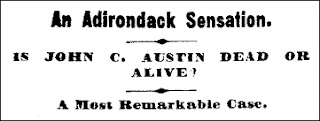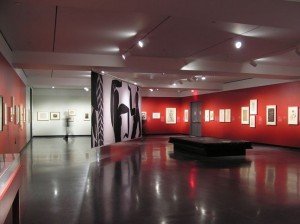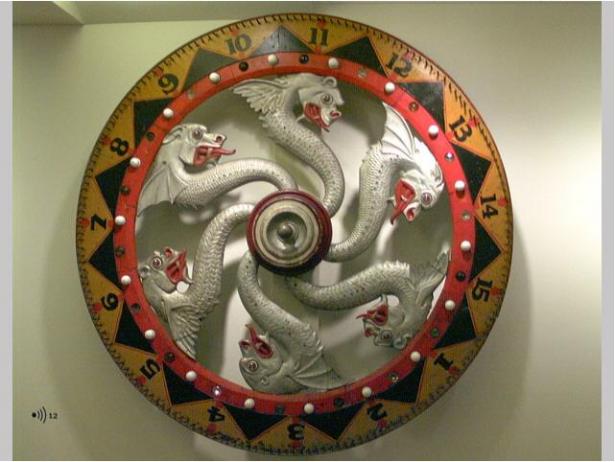 Adirondack guides from over a century ago are themselves part of the lore and history of the region. Their handling of city “sports,” coupled with their great abilities in the woods, provided the background for many a legendary tale. Guides were often strongly independent and shared a great affinity for the solitude of the deep woods. So what were nearly two dozen of these woodsmen doing in a New York City courtroom in the winter of 1893–94?They were present for the culmination of a terrific news story that had earned sustained coverage for more than two years. Dozens of American and Canadian newspapers followed the tale, which at times dominated the New York City media. A key component was its Adirondack connection.
Adirondack guides from over a century ago are themselves part of the lore and history of the region. Their handling of city “sports,” coupled with their great abilities in the woods, provided the background for many a legendary tale. Guides were often strongly independent and shared a great affinity for the solitude of the deep woods. So what were nearly two dozen of these woodsmen doing in a New York City courtroom in the winter of 1893–94?They were present for the culmination of a terrific news story that had earned sustained coverage for more than two years. Dozens of American and Canadian newspapers followed the tale, which at times dominated the New York City media. A key component was its Adirondack connection.
The story centered on well-known businessman John C. “Jack” Austin, 38, of Brooklyn. Fit, trim, and very athletic, he participated regularly in team and individual sports. In industry, he was known to have enjoyed success, providing a comfortable, if not wealthy, existence for his family. Austin’s wife died in February 1891, leaving him with three young children to raise, which he was doing with the aid of their very attentive housekeeper.The afternoon of July 4, 1891, was like any other holiday in Austin’s life, with plans to attend the horse races or go swimming at Manhattan Beach. He kissed the children good-bye and went on his way, promising to take them that evening to the Independence Day fireworks.Nearly nine hours later, the clerk at Manhattan Beach was performing the nightly check of the safe’s contents when he encountered an envelope bearing the name and street address of John Austin. For bathers visiting the beach, it was normal procedure to hire a bath room for changing clothes, and to deposit any valuables (wallet, cash, rings, watches) in envelopes provided by the facility. The owner received a numbered ticket which was later used to recover those goods.After finding the envelope with Austin’s name on it, the clerk searched Room #391, where he found a coat, vest, shirt, hat, trousers, and underwear. In the pockets of the clothing were a case of business cards, a penknife, some keys, and some pencils.Since it was nighttime and Austin’s personal belongings were still present, there was only one logical explanation: the owner likely had drowned. The clerk called for help, and in the presence of the bathing-pavilion superintendent, the Manhattan Beach chief of police, and a fireman, the security envelope was opened.Inside were items of varying value: a pocketbook containing a few dollars and some change- a ring with the letter S on it- and a lady’s gold watch and chain, studded with pearls.The family was contacted and apprised of the situation. Joseph Austin (John’s brother), and Thomas Carruthers (John’s brother-in-law) positively identified the belongings as John’s, and a search was initiated. For two days, police and volunteers patrolled the water and the beaches, covering not only Manhattan Beach, but the nearby shores of Jamaica Bay, Plum Island, Rockaway, and Sheepshead Bay.Veteran lawmen and experienced searchers knew what to do and where to look. Drownings were not uncommon off the shores of Coney Island, where tides and the prevailing winds routinely sent victim’s bodies to the shore sooner or later. Austin was presumed drowned, and alerts were issued to authorities on Staten Island as well as the New Jersey shore on the outside chance the body might surface there.Over the course of ten days, nothing was found, which in itself stirred suspicions. Some suggested that a northwest wind had driven the body out to sea, but police and beach veterans knew better. Austin’s room, #391, had been rented at about 4:00 pm, and for several hours following, a strong flood tide had pushed inland. To a man, they recognized it as an unusual circumstance that Austin’s body had not washed ashore—if he had, in fact, drowned.The family filed a claim with two insurance companies, where Austin’s coverage totaled $25,000 (equal to about $620,000 today). However, since no body had been recovered, one of the companies had already begun an investigation, despite the stellar public image of Austin as a respected, honest, hard-working family man. They wouldn’t be paying on the claim just yet.A number of peculiarities, both large and small, were noted in the situation surrounding John Austin’s disappearance. He was known to be wearing a very valuable diamond ring, but only an inexpensive ring was found in the envelope.The same was true of the lady’s watch that was found. Austin always wore his own watch, described as “a magnificent chronometer.” Friends and relatives said the valued watch was being repaired at a jeweler, but the insurance company discovered that the watch had been picked up on July 3, the day before he vanished. The jeweler’s shop was very near Austin’s office, but for some unknown reason, he had sent a messenger boy with a check to pick up the watch.It was also learned that John Austin patronized Manhattan Beach regularly and was well known to many of the workers—yet no one recalled seeing him on July 4. Further, on that day it was chilly and windy, reducing attendance to about 600 on a beach that often held many thousands of bathers. Despite the sparseness of the crowd, no employees could be found who had seen Austin.Co-workers and partners confirmed that the missing man always carried plenty of cash, almost never less than $100. And yet the envelope of his belongings held just a few dollars.He was also known to many as a very prolific and strong swimmer, often covering extreme distances. Drowning seemed an unlikely end for such a fit and able swimmer.Another possibility was floated: perhaps Austin had been hiding out while an imposter went to the beach on his behalf, used the changing room, and deposited the valuables (which had since been deemed not so valuable after all). That would explain why (in an unusually sparse crowd) no attendants had seen Austin. Maybe he hadn’t been there at all.Many more suspicious developments spurred further investigation, expanding far from the confines of New York City. Austin’s three orphaned children were now living with his sister, who was a resident of Montreal, Quebec. It was learned that their missing father was one of a great many city dwellers who frequented the Adirondacks for hunting and fishing expeditions. Since the Adirondacks were little more than an hour south of Montreal, investigators kept digging.It was then ascertained that John C. Austin was no stranger to the North Country. To be more specific, a number of those stalwarts of the north woods, the Adirondack guides, claimed to have not only seen Austin since his supposed drowning, but had guided him in several areas, including the Saranac Lake region.New developments caused further consternation. Of the two insurance policies which together were equal to well over $600,000 (in 2012), one had been secured by Austin on July 1, just three days before he vanished. And, after procuring the new policy, he had asked a secretary in the insurance office if it took effect at that very moment. It did seem an unusual query. With confirmation, he requested that the policy be sent to him ASAP. It was mailed that afternoon.A few witnesses eventually came forth, claiming they had seen a man disappear while swimming well offshore on July 4. Skeptical detectives suggested another scenario. Since Austin was widely known as a powerful swimmer, they believed he swam a few miles out, where he was picked up by a boat and secreted for a time at the home of his good friend, Henry LaMarche, south of Sandy Hook, New Jersey, not much more than ten miles from Manhattan Beach.LaMarche denied it, but his gardener and other employees stated emphatically that they had seen Austin with LaMarche in the days following the supposed drowning.Following up on Jack Austin’s great love of the north woods, detectives found many Adirondack guides who had known him over the years and claimed to have recently seen him and/or worked for him. One of them provided a photograph, said to have been taken recently. It showed Austin in full hunting gear. Confident now that this was a scam, the insurance companies denied the family’s claims, which were made on behalf of the children. Both sides had taken a firm stand, and the matter of whether or not John C. Austin was alive or dead would be decided by the courts.Thus, in December, 1893, about twenty Adirondack woodsmen found themselves en route to New York City for an extended stay, courtesy of the insurance companies. They were to testify about their interactions with Austin and the range of his movements.
It was learned that their missing father was one of a great many city dwellers who frequented the Adirondacks for hunting and fishing expeditions. Since the Adirondacks were little more than an hour south of Montreal, investigators kept digging.It was then ascertained that John C. Austin was no stranger to the North Country. To be more specific, a number of those stalwarts of the north woods, the Adirondack guides, claimed to have not only seen Austin since his supposed drowning, but had guided him in several areas, including the Saranac Lake region.New developments caused further consternation. Of the two insurance policies which together were equal to well over $600,000 (in 2012), one had been secured by Austin on July 1, just three days before he vanished. And, after procuring the new policy, he had asked a secretary in the insurance office if it took effect at that very moment. It did seem an unusual query. With confirmation, he requested that the policy be sent to him ASAP. It was mailed that afternoon.A few witnesses eventually came forth, claiming they had seen a man disappear while swimming well offshore on July 4. Skeptical detectives suggested another scenario. Since Austin was widely known as a powerful swimmer, they believed he swam a few miles out, where he was picked up by a boat and secreted for a time at the home of his good friend, Henry LaMarche, south of Sandy Hook, New Jersey, not much more than ten miles from Manhattan Beach.LaMarche denied it, but his gardener and other employees stated emphatically that they had seen Austin with LaMarche in the days following the supposed drowning.Following up on Jack Austin’s great love of the north woods, detectives found many Adirondack guides who had known him over the years and claimed to have recently seen him and/or worked for him. One of them provided a photograph, said to have been taken recently. It showed Austin in full hunting gear. Confident now that this was a scam, the insurance companies denied the family’s claims, which were made on behalf of the children. Both sides had taken a firm stand, and the matter of whether or not John C. Austin was alive or dead would be decided by the courts.Thus, in December, 1893, about twenty Adirondack woodsmen found themselves en route to New York City for an extended stay, courtesy of the insurance companies. They were to testify about their interactions with Austin and the range of his movements.
Next week: The conclusion?Adirondack guides from the big woods make a big impression in the big city.Photos: Top?Manhattan Beach, circa 1900. Bottom?Headline from the Austin case.
The story of John Austin is one of 51 original North Country history pieces appearing in Adirondack & North Country Gold: 50+ New & True Stories You’re Sure to Love (352 pp.), a recent release by author Lawrence Gooley, owner of Bloated Toe Publishing.
 A major new first-floor Brooklyn Museum gallery opened in March with Fine Lines: American Drawings, which will remain on view through May 28. The new 6,000-square-foot space is the latest step in a phased renovation that will, within the next two years, dramatically alter the entire first and second floors of the Museum’s McKim, Mead and White building.
A major new first-floor Brooklyn Museum gallery opened in March with Fine Lines: American Drawings, which will remain on view through May 28. The new 6,000-square-foot space is the latest step in a phased renovation that will, within the next two years, dramatically alter the entire first and second floors of the Museum’s McKim, Mead and White building.









